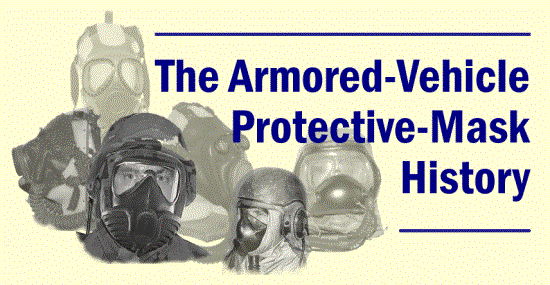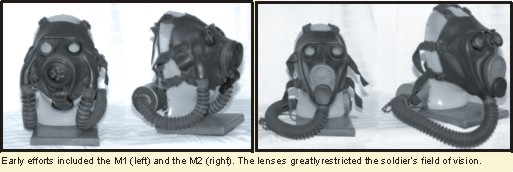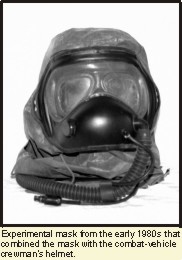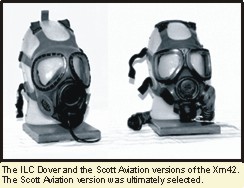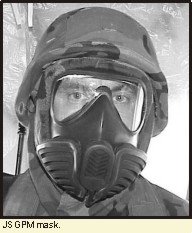|
By Major Robert D. Walk
In
addition to the modern use of chemical agents in war, armored vehicles
(tanks) were used first in World War I. The crewmen who operated these
armored vehicles required protection. Initially, these soldiers were
masked with the same mask as the infantry, but proper use of the sights
required the use of special masks. Since operating in a tank is like
operating in a confined space, air had to be supplied. After extensive
research, air suppliers or "collective protectors" were
developed and issued to tankers. They required special masks or adapters
for the standard mask to work properly. This is their story.
Early Efforts The
Chemical Warfare Service developed a gas mask for use with optical
instruments for the U.S. Navy in the 1920s. This was the experimental
Navy Diaphragm Optical (NDO) Mark I. The Army recognized the need for
the same capability and adopted the NDO as its optical gas mask, MI.
This mask had a filter mounted behind the head and a diaphragm to allow
better speech transmission. Although the theory was great, it was not
successful for Army use. The optical lenses were good, but were small,
which considerably narrowed the soldier’s field of view. The filter
mounted behind the head caused problems in the cramped confines of a
tank turret. It was still on the armored-battalion equipment lists in
1943, but it was not truly acceptable to the armored force.
The M2
optical gas mask replaced the MI optical gas mask. The M2, sort of an
NDO and lightweight gas-mask hybrid, had an NDO derivative facepiece
with a lightweight gas-mask hose and M10 filter. This mask was produced
in World War II with an M8 outlet valve and during the Korean conflict
with a C15 outlet valve. The M2 optical gas mask provided improvements
over the standard MI optical mask by mounting the filter on the
soldier’s side instead of behind the head. This improved the
soldier’s ability to maneuver inside the tank, but the soldier still
suffered reduced visibility inside the tank turret. Development of a
proper armored-vehicle crewman’s mask continued, but further work
included a centralized filter system to provide air for the vehicle
crew. Collective Protection Much
consideration was given to protecting the soldiers manning the tanks.
Soldiers operating in the cramped, stuffy confines of a tank could use a
blast of fresh air across the face. A formal requirement in 1943
established CWS D4.1-11, Collective Protectors for Tanks. Two
areas of research were initiated—positive pressure for a sealed-crew
compartment (fully overpressurized)—and supplied air to ventilated
facepieces for already existing tanks. The first (overpressure) system
was installed during manufacture, while the second (ventilated
facepiece) system was a retrofit for current vehicles. Beginning
with the T23 tank project, the idea of an incorporated collective
protector was included in the basic tank-design requirements. Because it
was difficult to seal tanks completely, particularly during firing the
main gun, the ventilated-facepiece program was more successful than the
overpressurized system. It is interesting to note that captured German
research revealed a planned overpressure system for their Tiger and
Panther tanks. The American ventilated-facepiece-system program resulted
in the E21-series collective protector.
Units
that were produced included the E21R2 with one filter unit that
protected one to three soldiers; the E21R3 with two filter units that
protected two to six soldiers; and the E21R4, which was an E21R3 with a
different filter unit. An M4A3 Sherman tank required two E21R2 units or
one E21R3 or E21R4 unit. In 1945, the E21R2 unit was considered
satisfactory for use in the Pacific for the impending invasion of Japan,
but the Army ground forces did not adopt it because of the lack of
detachable masks. The mask was also deficient when used with optical
devices. A
limited procurement (1,000 sets) of the E21-protector series was
authorized in World War II. One hundred-fifty E21R2s and 350 E21R3s were
produced. ElectroluxTM manufactured all units in
24 volt, while a 12-volt conversion set was authorized, but cancelled
after VJ-day. After
the war, research and development continued. Recognizing the need for
adequate protection for tank crews, work continued and the
specifications changed to include a removable mask for use by the tank
crew outside of the tank. Postwar research resulted in the E25-series
protector with two filter units and six masks. The blower used the
tank’s 24-volt system and delivered 3 1/2 cubic feet per minute of
filtered air to each tank crewman. Each mask could be easily
disconnected by the operator and used outside of the tank, eliminating
the need for the soldier to carry a standard service mask. While
the E25 system worked, it did not fit into standard armored vehicles.
Improvements and revisions resulted in the E26. Where the E25 was built
for six masks, the E26 was built for up to three masks. Most tanks at
that time required two E26s to protect the entire crew. Ultimately, the
first revision of the experimental model 26 (E26R1) was adopted in 1954
as the M8 three-man-tank collective protector. The M8
three-man-tank collective protector included an M2 air purifier, a
9-foot M6 tank protector hose, two 6-foot M7 tank protector hoses, and
three M14 (E56) tank protective masks. The air purifier first cleans the
air in a cyclone precleaner, filters the remaining particulates with a
paper filter, and removes the chemical agents with a charcoal filter.
The purifier can be used in or out of a chemical environment. The hoses
were placed close to crew stations, and the M14 masks were plugged into
the hoses when needed. Improvements
to the basic system in 1955 resulted in the M8A1 filter unit.
Installation of the M8A1 in tanks required the M20 installation kit. In
1959, after logistics problems were identified in getting the M20
installation kit and the M8A1 gas-particulate filter unit (GPFU) to the
appropriate locations for installation, the two were combined to become
the M8A2 filter unit—gas-particulate, tank, three-man, 12 cubic feet
per minute. At the same time, the M14 masks were removed from a
component of the end item and made separate end items. In 1963, the M8A3
became the final adopted version. These GPFUs were issued and mounted in
M41 tanks, M48 tanks, and M113 armored personnel carriers (APCs). This
unit is still a standard system in the M113-series APCs. The M8
collective protector was acceptable as long as no more than three
soldiers used the protector in one location. Certain experimental tanks
had more than three soldiers in one location so, in 1952, experimental
work began on a larger version. As an example, the M103A1 tank had four
soldiers in the turret, which required two M8 protectors. This was not
acceptable. Thus the Chemical Corps developed a more powerful
version—the E37-series tank collective protector. In addition to the
more powerful filter, this version included an airline heater to provide
heated, filtered air to the soldier. No storage space was required in
the vehicle because the unit was attached to ventilating ducts or placed
under the floor for access to the individual plug-in stations. The E37
unit consisted of five M14 masks, the M1 precleaner, five M1 canister
couplings, and one E38 20-cubic-feet-per-minute gas filter. The E37R1
was a modification to adapt the kit to any heater or cooling system in
the tank. This assembly, however, required storage space within the
tank. When the M60 tank was in development, the E37R2 filter unit
(adopted as the M13 collective protector) was developed especially for
it. This consisted of an M1A1 precleaner, E45 20 particulate filter, two
E44 10 gas filters, four E39 heaters, and the filter-unit hose. The M1A1
precleaner and E45 particulate filters were installed in a metal
housing. The air then flowed to the two E44 gas filters so that purified
air was conveyed through hose sections through a heater to the driver
and through a modified slip ring and then through heaters to sockets for
each crewmember. The crews attached their M14-series masks to
self-locking quick-release couplings when they needed them. The improved
M13A1 is used on the M60-series and M1-series tanks. After developing
good filtration systems, the Army concentrated on improving the
armored-vehicle crewman’s mask. Masks for the Collective Protector The M14
protective mask has a gray, 85 percent natural-rubber faceblank with a
large plastic, flexible lens designed so that air enters the chin and
deflects over the lens to prevent fogging. An air deflector was used and
not a true nosecup. The inner surface is stippled (rough) to allow a
better grip on the face and, thus, a better seal. A 2-foot hose supplied
air to an M10A2 filter. The M10A2 filter was an M10A1 filter with an M1
canister coupling. The M1 canister coupling was an adapter that attached
the filter to the M6 or M7 hose. The only reference to the M10A2 is the
early 1950s; thereafter, it was the M10A1 canister with M1 canister
coupling. An
M51/UR microphone mounted in front of the mouth inside the mask enabled
communications. A wire passed from the microphone through the facepiece
to a connector to plug into the intercom system. The M1 antidim kit was
included to reduce fogging in the mask. The operator carried the mask in
the M13 tank mask carrier. For long-term storage, the M6 faceform was
used to prevent distortion of the mask. Tests
found the M14 mask was acceptable, but not as good as the standard M9A1
protective mask. Other deficiencies noted in the mask included the
following: ·
A soldier could not wear
glasses with the mask.
·
The outlet airflow was bad.
·
The eye lens scratched
easily. ·
·
The mask had a tendency to
fog up. The
Chemical Corps worked to correct the problems. The
M14A1 (E56R2) (1960) mask included a nosecup capability; was constructed
of black rubber (for low-temperature flexibility); and had smooth inner
surfaces, better eye-lens adhesion, and improved eye-lens design. In
1961, atomic, biological, and chemical (ABC) protection was added to the
nomenclature to make it ABC-M14A1. The
M14A2 (E56R4), adopted in 1961, improved the mask by adding a permanent
C11 nosecup, eyeglass capability, M9 harness, and the E34 hood. This
mask was retained until the AN/ARC-44-series radio sets were deleted
from the inventory. This mask was standardized with Canada and Australia
in 1967. To modify this mask for the new radio sets, the M51/R
microphone was replaced with the M116G microphone and the mask became
the M25. The
initial M25 was only a remicrophoned M14A2 for use with the
AN/VRC-12-series radios. The M25A1 (E56R5) (1963) was an improved M25 by
adding an eye-lens outsert for arctic use and improving the fit. The
M25A1 mask took the U.S. Army into the 1990s. This mask was effectively
an M24 with a different microphone, simplifying logistics and
procurement. Problems with lens scratching from use with a tank’s
sighting systems never went away; therefore, research for a better mask
continued. Continuing Research Other
work in the 1960s involved adding an overpressure system for the MBT-70.
The idea of overpressure, rejected during World War II, resurfaced in
the 1960s. In an overpressure environment, soldiers working in the tank
can be in relative comfort while operating the tank in a contaminated
area. Every time the tank is fired, though, the overpressure can be lost
when reloading the cannon, and overpressure doesn’t help the soldier
when rapid egress is required in a contaminated environment. A
common-mask system would simplify logistics and save money. Thus, the
Army sought to develop a common-mask system—the XM29. This one mask
would use a common facepiece for all variations and would be of
one-piece, injection-molded, transparent, silicone rubber. The use of
this revolutionary materiel was a tremendous leap forward. Silicone
provides an excellent sealing to the face in a wide range of
temperatures and has no adverse skin toxicity. The mask used a
screw-mounted-filter canister that either mounted on the mask cheek
(right or left side) or on a hose. The side opposite the filter or hose
attachment had a voicemitter and a front voicemitter as well. The
tanker version of the mask had the appropriate microphone installed and
had a permanently attached hose to a separate filter mounted on the belt
or chest of the soldier. Unfortunately, the silicone itself did not
provide adequate protection against CB agents or the decontamination
chemical and required special coatings. In addition, the XM29 eye lens
had a tendency to "frost," but this could be corrected by
scrubbing it with a mild cleanser. The technology did not exist to coat
the silicone properly and allow it to remain transparent. Problems with
the lens coating led to the Army’s development of the XM30 series,
which was effectively an XM29 with a separate, glued-on lens. 1980s
Both the
U.S. Air Force and U.S. Navy have reliably used the inherent advantages
of a flexible, full-windshield lens in a flexible, silicone faceblank
for more than 18 years. Unfortunately for the Army’s part of the
program, in 1981 after an investment of more than $60 million dollars,
it received a Senator William Proxmire "Golden Fleece Award"
for a perceived waste of the taxpayers’ money. Shortly afterwards, the
Army’s portion of the program was dropped and a minimum-change,
minimum-risk program was initiated for the M40 series.
This
mask was adopted in 1987. It came in three sizes and included a
microphone and air-hose connections to the vehicle’s
collective-protection system. The M42 had a permanently attached air
hose. The M42A1 (1992) had most of the M40A1 mask improvements,
including a better nosecup and quick-doff hood. The M42A1 also allowed
the hose to be removed by incorporating a swivel connection on the hose.
The hose then became a repair part. By including the standard M40
facepiece and an external detachable microphone, it became the M42A2
mask in 1995 and is the Army’s present standard
armored-vehicle-crewman mask. Collective
protection improved during the 1980s. The M1 tank was fielded with the
M13A1 system. In the M1A1, this became a total protection system because
the overpressure system provided heated or cooled filtered air to the
soldiers manning the tank. Presently, most U.S. armored vehicles include
collective protection for the crew either using the ventilated facepiece
system (for example, M113 armored personnel carrier and the Bradley
fighting vehicle) or an overpressure system (for example, Abrams tank). The 1990s The
follow-on mask was scheduled to be the XM46, but was cancelled in 1995.
This was a hybrid of the XM45 aviator mask. Comparative testing in the
combat vehicle between the XM46 and XM42 did not demonstrate a
significant improvement over the M42, so it was abandoned.
Sustainment
will be considered throughout the design and testing phases of the
program. It is the DoD’s hope to maximize new, revolutionary
manufacturing methods and techniques to procure a proper mask that meets
the requirements but will have a low enough initial unit-issue cost to
consider alternative sustainment concepts. When grossly contaminated
with liquid CB agents or toxic industrial materials/toxic industrial
chemicals, or at the end of its service life, the mask would be disposed
of. The soldier, marine, or airman would then be issued a replacement
mask. The idea is to consider and simplify logistics. The
NBC-defense project manager will also work closely with other PMs that
are developing other components of the NBC ensemble (such as
overgarment, helmet, and gloves) to ensure that they meet the new
joint-service sustainment initiatives like "Vision 2010" to
create the best cost-effective, low-logistic-footprint protective mask
for the twenty-first century. This would help ease logistics in the
future battle-field (remember a good theater commander is always
concerned about logistics). Reduction in overall weight and bulk are
also critical, and the JSGPM mask must occupy less space than a
replacement M40 facepiece. The armored-vehicle version of the JSGPM is
the XM51. It includes the capability to attach to the vehicle’s
collective protection system and is compatible with
vehicle-communication systems. The XM51
is a technological leap forward, but it still has a long way to go. As
of February 2000, a benchmark "cradle-to-grave" developmental,
production, and sustainment request for quotation has been released. The
JSGPM is in its final source selection, and the initial
program-definition, risk-reduction phase will start later in FY00. Only
with the continued dedication of an extensive, joint-service
integrated-product team will the XM51 JSGPM be a success. If you have
spent time eating tanker dust or have a good idea or a bad experience,
don’t hesitate to write the PM. You can contact the system manager for
the JSGPM at his Web site (SBCCOMs). He wants to develop the best mask
for the soldiers, so he will review all ideas submitted. Conclusion The
search for the best protection for our armored vehicle continues.
Choosing the mask that performs best while logistically supportable is
difficult. During the years, the Army has examined and procured masks to
protect soldiers while continuing the search for the best mask. The
current standard mask, the M42A2, has an excellent protection factor.
Meanwhile, there is an ongoing search for a better mask in the JSGPM
program. In addition to masks, from no collective protection system
available in World Wars I and II, the Army has procured systems that
filter and heat the air as needed to reduce the stress to the soldier in
the tank. Future ideas in collective protection include the possibility
of using catalysts to destroy chemicals drawn into the
tank—eliminating the need for carbon filters that must be replaced.
What will be next? Only the PM knows for sure… Major
Robert D. Walk is currently assigned to the U.S. Army Reserve
Command’s DCSOPS in the Weapons of Mass Destruction Division. He is a
graduate of the Command and General Staff College and the Army Chemical
School. He is a graduate of the University of New Hampshire with a B.S.
degree in chemical engineering, an M.B.A. degree from Long Island
University, and an M.S. degree in civil environmental engineering from
the University of Oklahoma. MAJ Walk can be contacted through the
Chemical Doctrine Net.
|
